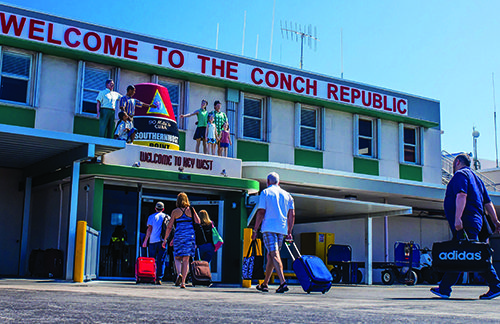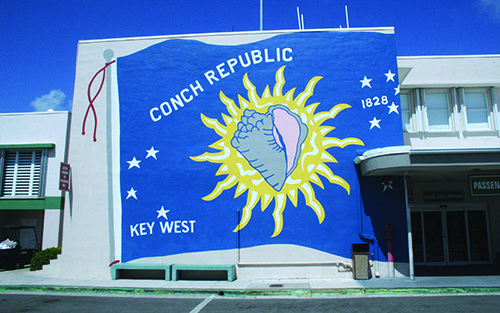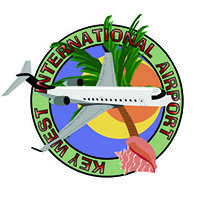Key West may be a small town of only 25,000 residents, but it’s a thriving tourist spot that’s growing in popularity. As a result, passenger traffic at Key West International Airport (EYW) is also projected to rise—to the tune of 2.4% per year for the next 20 years. Airport executives estimate that 750,000 travelers will pass through their island facility by the end of 2018.
“There are few places I can think of that are quite like the Florida Keys,” says Thomas J. Henderson, acting director of airports for Monroe County, which owns and operates EYW. “It has a lot of aviation history, going back to international air service from the Keys to Havana. When people arrive here, they get the full experience of landing at an island airport.”
This spring, EYW completed a $10 million renovation of its sole runway to ensure that the “full experience” included smooth landings and takeoffs. At only 4,801 feet long, Runway 9-27 is able to accommodate aircraft as large as Boeing 737s. Despite occasional weight restrictions, Delta Air Lines, American Airlines, United Airlines and Silver Airways operate direct air service to a number of cities from EYW.
|
Project: Runway Reconstruction Location: Key West (FL) Int’l Airport Runway Length: 4,801 ft. Cost: $10 million Funding: FAA; FL Dept. of Transportation; passenger facilities charges Construction: 5 months Asphalt Installed: 24,000 tons Project Completed: April 2018 Pavement Engineering Consultant: RDM Int’l Inc. Project Consultant: Jacobs General Contractor: General Asphalt Subcontractor: Charley Toppino & Sons Airfield Lighting: Florida Keys Electric Inc. |
Renovation vs. Relocation
EYW and its general aviation counterpart, Florida Keys Marathon Airport (MTH), are both covered by a Florida Department of Transportation program that contracts an engineering firm to conduct periodic inspections of airfield pavement throughout the state. Based on these inspections, Henderson and his team knew that Runway 9-27 was safe but would need to be replaced soon.
“The runway pavement was at the end of its serviceable life span,” says Jacobs Project Manager Lasa Ennis. “When runways are not maintained on time, foreign object debris (FOD) tends to break up on the runway.”
Airport personnel had not experienced problems with FOD on the runway, and they wanted to keep it that way. Officials consequently scheduled a reconstruction project to:
• mill and overlay the existing runway surface with new pavement;
• widen the shoulders from 10 to 20 feet on both sides;
• upgrade runway lighting to LED;
• add 270 feet of takeoff distance; and
• improve drainage in the grass safety areas that abut the runway.
The new pavement overlay strengthened and improved the condition of the runway for years to come, notes Ennis.
Opting for Asphalt
During the design phase, engineers took into account factors like weather and the rising sea level. They specified asphalt instead of concrete so the new runway surface would cure quickly, and disruption to air traffic would be minimal.
“Asphalt is quicker for constructability, especially when you have to re-open a runway each morning throughout construction,” says Ennis, who also acted as the engineer of record on the project.
One of the first challenges the project team ran into was material procurement. General Asphalt, the Miami-based company that won the contract, was located three hours away, via the long, bridge-laden Overseas Highway that connects the Keys to each other and the mainland.
“We had to put a provision in the plan that said crews could not begin milling until the asphalt trucks were an hour away from the airport,” notes Ennis.
Workers milled about ½ inch from the existing runway to rough up the surface and help the new asphalt adhere. They then placed asphalt until 5 a.m., which allowed time for the asphalt to cure and crews to clean up the worksite before the first flights at 7 a.m.
The new design elevated the runway by 6 inches, which required 24,000 tons of asphalt. On average, crews placed 650 tons of asphalt each night.
The work schedule was developed around Key West’s rainy season. Paving began in January, because the first three months of the year are typically the driest. However, that time of year is also part of Florida’s busy snowbird season, which runs from December to March.
Finding the Rhythm
In order to complete the project within a five-month window, EYW closed its sole runway every night at 10 p.m. and reopened at 7 a.m. Airport personnel worked closely with the airlines to help maintain normal operations throughout construction.
 “We entered this project with the right mindset and good preparation,” says Henderson. “Like any airport with a single runway, we knew we needed to do this at night and ensure we had smooth runway closure and demobilization, and clean up and be ready for business by 7:00 the next morning. We got in a rhythm that helped.”
“We entered this project with the right mindset and good preparation,” says Henderson. “Like any airport with a single runway, we knew we needed to do this at night and ensure we had smooth runway closure and demobilization, and clean up and be ready for business by 7:00 the next morning. We got in a rhythm that helped.”
Ennis and Henderson agree that communication between the various work crews was crucial to their success. At peak, there were up to 50 workers on the runway each night. Henderson reports that construction was largely seamless, thanks to good planning and coordination. He also credits the airport’s relationship with Jacobs as instrumental to moving the project forward.
“We had weekly progress meetings, and we also had a communication line and an airport representative from Jacobs on site,” adds Ennis. ”Updates were reported daily between on-field representatives, myself, the airport and the contractor.”
Knowing crews could not build the runway in one night, the team planned precisely how much runway they could cover with each night’s production. For every inch of asphalt overlay on the existing runway, contractors had to build a 15-foot ramp to ensure smooth takeoffs/landings and comply with FAA regulations.
 “There were no surprises during construction,” reports Ennis. “The biggest challenge was the timing. Construction went smoothly because we planned well in our design phase; plus, we had an experienced contractor in General Asphalt. They were very knowledgeable about their product and had worked on numerous runways. They knew that if the runway is just a minute past opening, they are losing money. They were very aware and respected that timeline, and they were prepared.”
“There were no surprises during construction,” reports Ennis. “The biggest challenge was the timing. Construction went smoothly because we planned well in our design phase; plus, we had an experienced contractor in General Asphalt. They were very knowledgeable about their product and had worked on numerous runways. They knew that if the runway is just a minute past opening, they are losing money. They were very aware and respected that timeline, and they were prepared.”
Grooving the runway had to be finished by April 15, but was completed ahead of schedule on April 7. Afterward, crews placed sod, installed new inlets on the drainage line for the infield areas, raised all edge and threshold lights, and built a concrete area on the west side of the runway for turning maneuvers.
Minimal Impact
Of the four airlines that operate out of EYW, Delta was the only one that had to alter operations during the runway project, and it experienced only minor scheduling impacts. Because the runway had to remain ungrooved while the asphalt cured completely for 30 days, the runway’s friction coefficient would be compromised during wet conditions. That combined with the runway length affected certain flights.
 “We had to closely monitor wet versus dry conditions for Delta to operate,” explains Henderson. “Since the project was in the winter and spring, we didn’t have any cancelled flights due to wet runway. Delta had three diversions, but we still consider that a success. Silver, United, and American didn’t experience any operational impact.”
“We had to closely monitor wet versus dry conditions for Delta to operate,” explains Henderson. “Since the project was in the winter and spring, we didn’t have any cancelled flights due to wet runway. Delta had three diversions, but we still consider that a success. Silver, United, and American didn’t experience any operational impact.”
While airfield improvements typically create some inconveniences and frustration, Henderson and Ennis agree that pre-planning and proactive communication about the project managed expectations and mitigated most complaints.
“I would recommend that all major parties involved in a project like this—maintenance, operations, air traffic control, station managers, engineering consultants, and all of the players—need to be a part of the planning process at least a few months ahead, so they can see it coming and plan accordingly,” says Henderson.
With runway renovations complete, taxiway and terminal improvements will be the next major projects at EYW. The airport plants to expand its 2009 terminal and add a new departures lounge and connections to jet bridges to enhance passenger safety.
“We promote a positive, customer-friendly experience,” explains Henderson, noting that the airport is now ready for the next generation of Key West visitors.



 facts&figures
facts&figures

